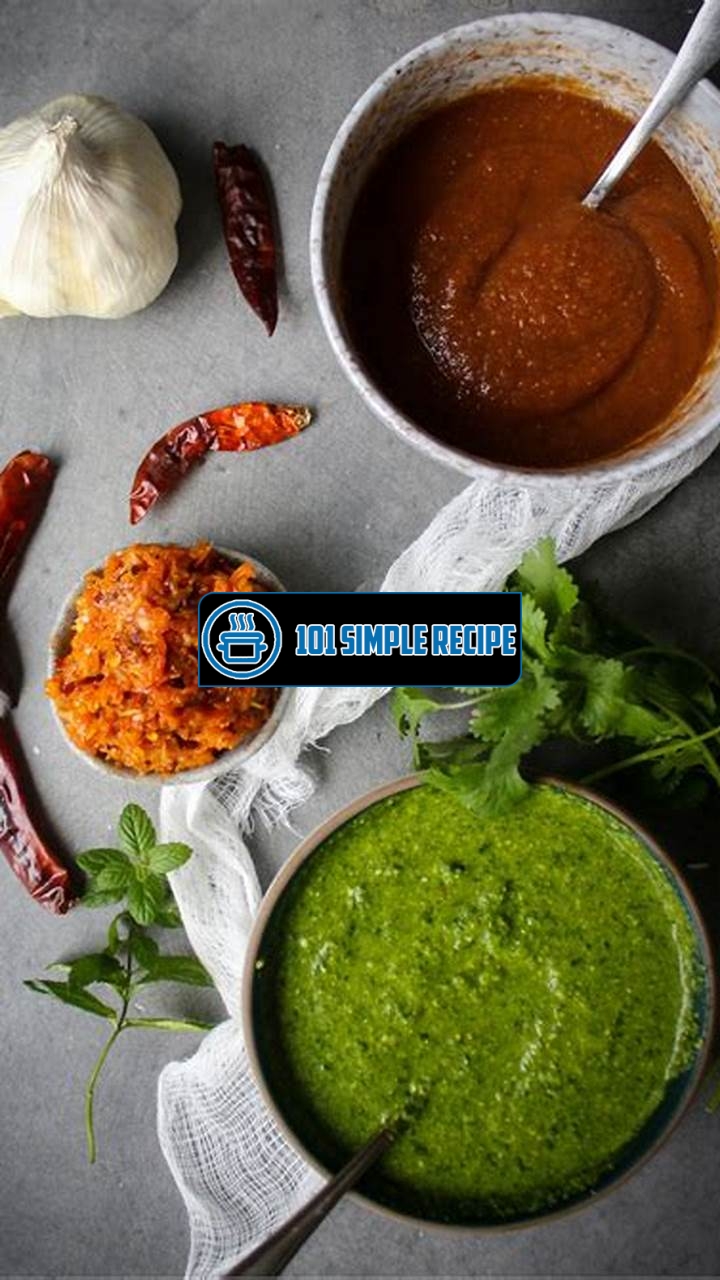Are you a fan of Indian cuisine? Do you crave the bold and vibrant flavors that are unique to this rich culinary tradition? If so, then it’s time to discover the authentic flavors of Indian chutney recipes. ️ Made with a blend of savory, spicy, and tangy ingredients, chutneys are a versatile accompaniment that can elevate any meal to a whole new level. Whether you prefer the heat of coriander and mint chutney or the sweetness of mango chutney, there is a flavor combination that will tantalize your taste buds. So, join us on a virtual journey through the tantalizing world of Indian chutney recipes, and unlock the secrets to creating these delightful condiments in your own kitchen.

What is Chutney?
Chutney is a delicious and versatile condiment that is an integral part of Indian cuisine. It is a sauce or relish made from a combination of fruits, vegetables, herbs, spices, and other ingredients. Chutney can be sweet, tangy, spicy, or a combination of these flavors, making it a perfect accompaniment to a wide variety of dishes.
️ Chutney adds a burst of flavor to any meal and can be used as a dipping sauce, spread, or topping for various dishes. It is commonly served with appetizers, snacks, main courses, and even desserts, adding depth and complexity to every bite.
The History of Chutney
The origins of chutney can be traced back to ancient India, where it was initially used as a way to preserve fruits and vegetables. The word “chutney” is derived from the Hindi word “chatni,” which means to lick. This suggests that chutney was meant to be savored and enjoyed.
Chutney has a long history and has evolved over time with diverse regional variations. It was introduced to the Western world during the era of British colonization in India, and its popularity quickly spread across the globe.
What is Chutney Made of?
Chutney recipes can vary greatly depending on the region and personal preferences. However, the essential ingredients typically include a base of fruits or vegetables, such as mangoes, tomatoes, apples, or mint leaves. Additional ingredients like onions, garlic, ginger, spices, vinegar, and sugar are also commonly used.
The use of spices in chutney is crucial, as they contribute to its distinct flavors. Some commonly used spices include cumin, coriander, chili powder, turmeric, mustard seeds, and fenugreek. These spices not only add heat and depth but also enhance the overall taste and aroma of the chutney.
Different Varieties of Chutney
There are countless varieties of chutney, each with its own unique combination of flavors. Some popular types of chutney include:
- Mango Chutney: Made with ripe mangoes, this sweet and tangy chutney is a classic favorite.
- Tomato Chutney: A spicy and tangy chutney made with tomatoes, onions, and a blend of aromatic spices.
- Mint Chutney: A refreshing and vibrant chutney made with fresh mint leaves, cilantro, green chilies, and lime juice.
- Coconut Chutney: A creamy and slightly sweet chutney made with grated coconut, ginger, green chilies, and tempered with mustard seeds and curry leaves.
Chutney recipes can also vary based on the region, such as the spicy and fiery green chutneys of North India or the coconut-based chutneys of South India.
Overall, chutney is a versatile and flavorful condiment that adds a delightful twist to Indian cuisine. Whether you’re serving it with samosas, dosas, or simply enjoying it as a dip, chutney is a must-try for those who want to explore the authentic flavors of Indian cuisine.
Traditional Chutney Recipes
Explore classic Indian chutney recipes that have been passed down through generations.
Mint Chutney
Mint chutney is a refreshing and flavorful condiment that is a staple in Indian cuisine. Made with fresh mint leaves, this chutney adds a burst of vibrant green color and a tangy taste to any dish. It is commonly served with appetizers like samosas and pakoras, or as a accompaniment to main dishes like biryani or kebabs.
To make mint chutney, start by washing a bunch of fresh mint leaves and removing the stems. In a blender or food processor, combine the mint leaves with garlic cloves, green chilies, lemon juice, and a pinch of salt. Blend until smooth, adding a little water if needed to achieve the desired consistency. Transfer the chutney to a serving bowl and garnish with a sprinkle of roasted cumin powder. Enjoy the mint chutney with your favorite Indian dishes!
Coriander Chutney
Coriander chutney, also known as cilantro chutney, is another popular Indian condiment that is bursting with flavors. Made with fresh coriander leaves, this chutney has a vibrant green color and a tangy and slightly spicy taste. It is commonly used as a dip or spread for snacks like pakoras, sandwiches, or as a topping for chaat.
To make coriander chutney, wash and roughly chop a bunch of fresh coriander leaves, including the stems. In a blender or food processor, combine the coriander leaves with green chilies, ginger, garlic, lemon juice, and a pinch of salt. Blend until smooth, adding a little water if necessary. Transfer the chutney to a serving bowl and garnish with a drizzle of olive oil. Your homemade coriander chutney is ready to be enjoyed!
Tamarind Chutney
Tamarind chutney is a sweet and tangy condiment that is commonly used in Indian street food. Made from tamarind pulp, jaggery (unrefined sugar), and a blend of spices, this chutney has a rich, dark brown color and a sweet and sour taste. It is typically served with samosas, chaat, or as a dipping sauce for pakoras or kebabs.
To make tamarind chutney, soak some tamarind pulp in warm water for about 15 minutes, then strain the pulp to remove any seeds or fibers. In a saucepan, combine the tamarind pulp with jaggery, water, and a mix of spices like cumin, ginger powder, black salt, and red chili powder. Cook the mixture on low heat until it thickens to a syrup-like consistency. Allow the chutney to cool before transferring it to a jar for storage. Indulge in the amazing flavors of homemade tamarind chutney!
Regional Chutneys in India
India is known for its rich culinary traditions, and one of the most versatile and flavorsome condiments in Indian cuisine is chutney. Chutney refers to a variety of savory and tangy sauces or dips that are typically made with a combination of fruits, vegetables, herbs, and spices. These delightful creations add a burst of flavor and a hint of spice to any meal. What makes Indian chutneys truly fascinating is the incredible regional diversity found across the country. Each region boasts its own unique chutney recipes, utilizing local ingredients and cooking techniques.
South Indian Coconut Chutney
In the southern part of India, coconut chutney is a staple accompaniment to many traditional dishes. This creamy and mildly spiced chutney is made from freshly grated coconut, roasted lentils, green chilies, and a hint of tanginess from tamarind. The ingredients are ground together to form a smooth paste, which is then tempered with mustard seeds, curry leaves, and a touch of asafoetida. The result is a refreshing and fragrant chutney that perfectly complements the flavors of dosas, idlis, and vadas – popular South Indian breakfast foods.
Key points:
- South Indian coconut chutney is a creamy and mildly spiced condiment.
- Made from grated coconut, roasted lentils, green chilies, and tamarind.
- The chutney is tempered with mustard seeds, curry leaves, and asafoetida.
- Pairs well with dosas, idlis, and vadas.
Maharashtrian Peanut Chutney
In the state of Maharashtra, peanut chutney takes center stage. This lip-smacking chutney is known for its rich, nutty flavor and velvety texture. Roasted peanuts are ground along with garlic, dried red chilies, and a blend of aromatic spices. A splash of tangy lemon juice and a pinch of sugar impart a delightful balance of flavors. This chutney is a versatile accompaniment, elevating the taste of popular Maharashtrian dishes like vada pav, thalipeeth, and batata vada.
Key points:
- Maharashtrian peanut chutney has a rich, nutty flavor and velvety texture.
- Made from roasted peanuts, garlic, dried red chilies, and spices.
- Enhanced with lemon juice and a touch of sweetness from sugar.
- Perfect for vada pav, thalipeeth, and batata vada.
Bengali Tomato Chutney
As you move towards the eastern part of India, you’ll discover the tangy and sweet flavors of Bengali tomato chutney. This vibrant chutney showcases ripe tomatoes simmered with a medley of spices like cinnamon, cloves, and ginger. A dash of sugar and a hint of tanginess from tamarind balance out the flavors. The chutney has a chunky texture, and the spices impart a warm and aromatic taste. Bengali tomato chutney is traditionally enjoyed with popular dishes like maach bhaat (fish and rice) and pitha (sweet rice cakes).
Key points:
- Bengali tomato chutney offers tangy and sweet flavors.
- Made by simmering ripe tomatoes with cinnamon, cloves, and ginger.
- Features a chunky texture and warm, aromatic taste.
- Paired traditionally with maach bhaat and pitha.
When it comes to exploring the flavors of Indian chutneys, the regional variations provide a delightful journey through the diverse culinary landscape of India. Whether you prefer the creamy coconut chutney of the south, the nutty goodness of the Maharashtrian peanut chutney, or the tangy sweetness of Bengali tomato chutney, each one is guaranteed to tantalize your taste buds and add an authentic touch to your Indian dining experience.
Health Benefits of Chutney
Discover the nutritional advantages of incorporating chutney into your diet. Chutney is a condiment that originated in India and is widely used in Indian cuisine. It is made from a combination of fruits, vegetables, herbs, and spices, creating a flavorful and versatile sauce that can be used as a dip, spread, or accompaniment to main dishes.
Aids in Digestion
One of the key health benefits of chutney is its ability to aid in digestion. The combination of ingredients used in chutney, such as ginger, garlic, and cumin, help stimulate the secretion of digestive enzymes, promoting better digestion. Chutney also contains fiber, which helps regulate bowel movements and prevents constipation. ️
Rich in Antioxidants
Chutney is packed with antioxidants due to the inclusion of ingredients like onions, tomatoes, and various herbs and spices. These antioxidants help combat free radicals in the body, reducing the risk of chronic diseases such as heart disease and cancer. Additionally, antioxidants have anti-inflammatory properties, which can help alleviate symptoms of arthritis and other inflammatory conditions.
Boosts Immunity
Another significant health benefit of chutney is its ability to boost immunity. Many ingredients commonly used in chutney, such as garlic, ginger, and turmeric, have natural immune-boosting properties. These ingredients contain compounds that can help fight off infections and strengthen the immune system. By incorporating chutney into your diet, you can enhance your body’s ability to ward off illnesses and stay healthy.
In conclusion, chutney is not only a delicious condiment but also offers numerous health benefits. It aids in digestion, thanks to its digestive enzyme-stimulating ingredients. It is also rich in antioxidants, which help combat free radicals and reduce the risk of chronic diseases. Additionally, chutney boosts immunity, thanks to its immune-boosting ingredients. By incorporating chutney into your meals, you can enjoy its authentic flavors while reaping these nutritional advantages.
Creative Ways to Use Chutney
When it comes to Indian cuisine, chutney plays a vital role in enhancing the flavors of various dishes. While it is commonly used as a condiment or a side dish, the versatility of chutney extends beyond these traditional roles. In this article, we will explore some creative and delicious ways to incorporate chutney into your meals and snacks, taking your culinary experience to a whole new level.
Chutney as a Dipping Sauce
One of the simplest yet delightful ways to enjoy chutney is by using it as a dipping sauce. Whether you’re enjoying a plate of samosas, pakoras, or even grilled vegetables, chutney can add a burst of flavor and tanginess to each bite. Simply pair your favorite chutney with your chosen snack, dip it in, and savor the explosion of taste. ️
If you’re feeling adventurous, you can even try making a chutney-based dip for your chips or nachos. Mix some mint chutney with yogurt and a dash of lime juice for a refreshing and tangy dip. The possibilities are endless when it comes to using chutney as a dipping sauce.
Chutney as a Marinade
Are you tired of using the same old marinades for your meats and vegetables? Spice things up by incorporating chutney into your marinade recipe. The flavorful blend of spices and herbs in chutney can infuse your proteins with an authentic Indian taste that will leave your taste buds craving for more.
For instance, mix coriander chutney with yogurt, ginger, garlic, and a squeeze of lemon juice to create a marinade for chicken tikka. Allow the chicken to marinate for a few hours or overnight to tenderize the meat and allow the flavors to penetrate. Once cooked, you’ll be rewarded with juicy and flavorful chicken that’s sure to impress your guests.
Chutney as a Spread
Why limit yourself to conventional spreads like mayonnaise or ketchup when you can introduce a burst of flavor with chutney? Whether you’re making sandwiches, wraps, or even burgers, using chutney as a spread can take your dish to a whole new level.
Spread some tangy tamarind chutney on a crispy dosa for an authentic South Indian twist. Use tomato chutney as a base for a homemade pizza instead of traditional marinara sauce. The sweet and savory flavors of chutney will add a unique depth to your dishes, making them stand out from the ordinary.
In conclusion, chutney is not just a mere condiment; it is a versatile ingredient that can elevate your culinary creations to new heights. Experiment with different flavors of chutney and see how they can transform your meals and snacks. Whether you use chutney as a dipping sauce, a marinade, or a spread, it’s time to unleash your creativity in the kitchen and experience the authentic flavors of Indian chutney recipes.
old fashioned butter cookie recipe
Frequently Asked Questions
Thank you for reading our article on “Chutney Recipe Indian”! We hope you found it informative and inspiring. If you have any further questions or need clarification on any aspect of the recipe, please refer to the FAQ section below:
| No. | Questions | Answers |
|---|---|---|
| 1. | What ingredients do I need to make Indian chutney? | The main ingredients for Indian chutney typically include fresh herbs, spices, fruits or vegetables, vinegar, and sugar. However, specific variations may call for additional ingredients such as coconut, tamarind, or nuts. |
| 2. | How do I store homemade chutney? | Homemade chutney can be stored in an airtight container in the refrigerator for up to one week. For longer shelf life, you can also freeze chutney in freezer-safe containers or bags. |
| 3. | What are some popular variations of Indian chutney? | Some popular variations of Indian chutney include mint chutney, coriander chutney, tomato chutney, coconut chutney, and mango chutney. These variations offer different flavors and can be paired with various Indian dishes. |
| 4. | Can I adjust the spice level in the chutney? | Absolutely! The spice level can be adjusted according to your preference. If you prefer milder flavors, reduce the amount of chili or other hot spices. Conversely, if you enjoy spicier chutney, you can increase the amount of spice. |
| 5. | What dishes can I pair Indian chutney with? | Indian chutney can be paired with a wide range of dishes, such as samosas, dosas, pakoras, parathas, and even as a condiment for grilled meats or sandwiches. Its versatile flavors add a delicious touch to many Indian recipes. |
| 6. | Can I make chutney in advance for a special occasion? | Yes, making chutney in advance is a great idea for special occasions or gatherings. It allows the flavors to meld together and intensify over time, resulting in a more delicious chutney. Just make sure to store it properly in the refrigerator. |
Thank You for Reading!
We sincerely thank you for taking the time to read our article on “Chutney Recipe Indian”. We hope it has provided you with valuable insights and inspiration to try making your own delicious Indian chutney. Remember, experimenting with different ingredients and spice levels can help you create the perfect chutney that suits your taste buds. If you have any further questions or would like to explore more recipes, feel free to visit our website again. Happy cooking and enjoy your flavorful journey!
Jump to Recipe
Chutney Recipe Indian

Discover the authentic flavors of Indian chutney with our delicious recipe guide. Learn how to make different variations of this versatile condiment that pairs perfectly with various dishes. Spice up your meals with homemade chutney that will tantalize your taste buds.
- 2 cups fresh coriander leaves
- 1 cup fresh mint leaves
- 2 green chilies
- 1- inch piece ginger
- 2 cloves garlic
- 1 tablespoon lemon juice
- 1 teaspoon sugar
- 1/2 teaspoon salt
- Wash the coriander and mint leaves thoroughly. Chop them roughly.
- In a blender, combine the coriander, mint, green chilies, ginger, and garlic. Blend until smooth.
- Add lemon juice, sugar, and salt to the blender. Blend again until well combined.
- Transfer the chutney to a jar or bowl and refrigerate for at least 30 minutes before serving.






